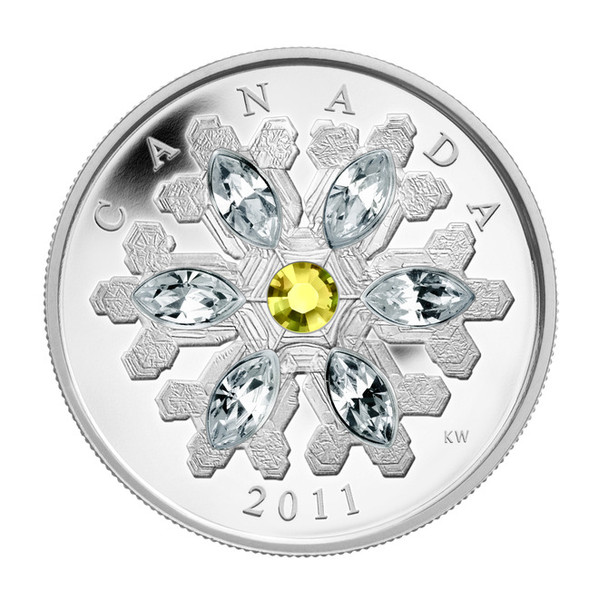Description
Theme:
The War of 1812 was a fundamental turning point in Canada’s development as a nation; the stories and the heroes that arose from it have become enduring elements of the Canadian story.
Description:
The reverse image by Canadian artist Bonnie Ross features, in the foreground, a three-quarter profile portrait of Laura Secord set against an intricately engraved background comprised of the bilingual text “The War of 1812/La guerre de 1812.” This background is horizontally bisected by a polished silver band featuring the embossed word “Secord” in cursive lettering. Beneath this band is the engraved and painted Government of Canada War of 1812 logo composed of the date “1812” in stylized script laid over a red stylized maple leaf with ecru swords crossing behind it. The reverse is also embossed with the face value of “4 DOLLARS.” The obverse features the effigy of Her Majesty Queen Elizabeth II by Susanna Blunt.
Special Features:
- Created to commemorate the bicentennial of the War of 1812, this unique portrait coin is one of four in a series celebrating Canadian Heroes of the War of 1812, and part of a larger collection devoted to commemorating the 200th anniversary of this important event in Canadian history. Previous coins include: Tecumseh, Sir Isaac Brock and Charles-Michel de Salaberry.
- An attractive collectible for numismatists, military enthusiasts, and lovers of Canadian history alike.
- The coin features Laura Secord against an intricately engraved background comprised of the words “The War of 1812” in both English and French. Featured in the design is the engraved and painted Government of Canada War of 1812 logo: composed of stylistic 1812 typography encompassed by a stylized maple leaf with ecru swords crossing behind it.
- The stunning three-quarters profile of this important Canadian figure is engraved to the Royal Canadian Mint’s exacting standards in 99.99% fine silver.
- Intricate and elegant design is finely engraved and meticulously presented in a beautiful Proof finish (frosted raised elements on mirror background); a testament to the exceptional talents of the designer and unparalleled RCM craftsmanship.
Product Specifications:
Face Value: 4 Dollars
Mintage: 10,000
Composition: 99.99% fine silver
Weight (g): 7.96
Diameter (mm): 27
Edge: Serrated
Finish: Proof
Certificate: Serialized
Artist: Bonnie Ross
Advertising Date: June 4, 2013
Launch Date: June 11, 2013
Packaging:
Coin is encapsulated and presented in a Royal Canadian Mint-branded maroon clamshell case lined with flock and protected by a custom beauty box.
Complete Certificate Text:
Heroes of the War of 1812
The War of 1812 was a fundamental turning point in Canada’s history: it profoundly influenced British North America’s (Canada’s) sense of identity and united French- and English-speaking inhabitants, Aboriginal communities, farmers, soldiers, artisans, and others, in an effort to preserve their ways of life from American invasion.
From the struggle emerged exceptional accounts of some of Canada’s proudest moments. These stories and the heroes that arose from them exemplified the extraordinary characteristics required to defend British North America, and have become important symbols and enduring narratives in the history and evolution of today’s Canada.
A Heroine’s Journey into Legend: Laura Secord (1775 - 1868)
Like many of the “Late Loyalists”, Laura Ingersoll was born in the United States but emigrated to Canada. She did so in 1795, when her father, Thomas Ingersoll, moved 20-years old Laura, her four sisters, and her step-family from Great Barrington, Massachusetts, to the township of Queenston (now Ingersoll, Ontario) in the Niagara Peninsula. He did so to benefit from free settlement grants offered under Lieutenant-Governor Lord Simcoe.
Two years later, in 1797, Laura married James Secord. The young couple raised one son and six daughters together. James—a merchant by trade but also a sergeant in the local militia—was seriously wounded in the famous Battle of Queenston Heights in October 1812. Laura found and rescued her husband as he laid on the battlefield.
Famously, on June 20 or 21, of 1813, Laura overheard some American officers discussing their intention to ambush a British outpost at the DeCou House, near Beaver Dams and capture its commanding officer, Lieutenant James FitzGibbon. Early the next morning, Laura set out on foot to warn Lieutenant FitzGibbon who was roughly 30 kilometres (20 miles) away. She successfully delivered her message first to about 400 First Nations warriors, then FitzGibbon on June 22, 1813. On June 24, 1813, when American forces thought they had Beaver Dams, in their grasp, they were ambushed by the First Nations Warriors. FitzGibbon’s 50 British soldiers arrived in time to accept the American surrender.
But as Secord’s story was woven into the lore of the War of 1812, fascinating new and exotic fictions began to obscure the facts surrounding her trek. For example, it was claimed that she had made the journey barefoot, that she took a cow with her for camouflage, that she milked said cow as a “cover” when found by American sentries patrolling the region. Most scholars agree that it is unlikely that a pragmatic pioneer woman would have set out on a 30-kilometre quest without shoes (and sensible ones at that). As for the cow: it is not mentioned in Secord’s memoirs and is unlikely that in such a vast wooded region Secord would have encountered sentries.
Laura Secord did not receive public recognition until just before her death. In 1860, the Prince of Wales (the future Edward VII) visited Canada and learned of Secord’s journey. Upon his return to England, he sent Secord a reward of £100 and publicly lauded her contribution as a war hero. She died in 1868, at the age of 93, and was buried beside her husband in Drummond Hill Cemetery, Niagara Falls.

















